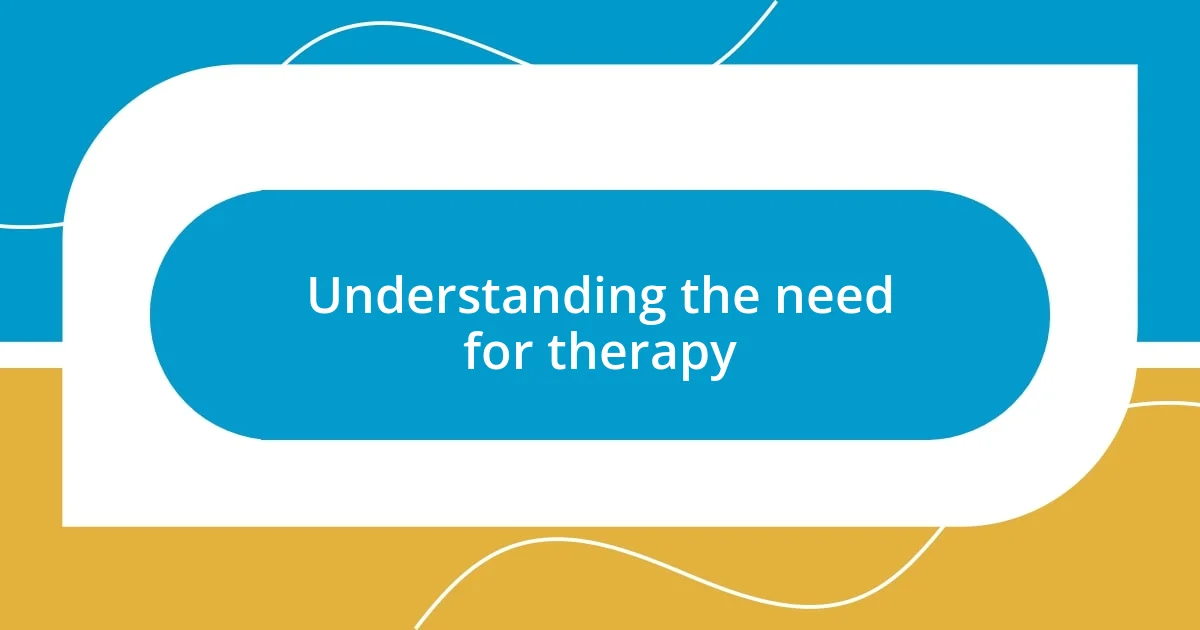Key takeaways:
- Recognizing the need for therapy can lead to personal growth and a better understanding of one’s emotions, rather than simply being a solution for crises.
- Setting specific therapy goals helps guide the therapeutic process and promotes accountability, allowing for adjustments as one progresses.
- Building a strong therapeutic relationship relies on trust, open communication, and consistency, while being aware of when it might be time to seek a different therapist if needs are not being met.

Understanding the need for therapy
Recognizing the need for therapy can be a profound journey. I remember sitting in my car one afternoon, overwhelmed with emotions—anxiety swirling and my mind racing. It struck me, almost like a lightbulb moment: “Is it okay to seek help?” Understanding that I wasn’t alone in feeling this way was crucial to my decision to pursue therapy.
It’s easy to dismiss signs like persistent sadness or stress as just part of life. I often thought, “Everyone struggles; I just need to toughen up.” Yet, this mindset kept me stuck in a cycle of frustration and isolation. This realization made me wonder: what if seeking help could actually empower me? Therapy isn’t simply for those in crisis; it can be a valuable tool for anyone looking to explore their emotions or patterns of behavior.
The moment I acknowledged my need for support, it felt like a weight lifted off my shoulders. It was as if I had unlocked a door to a space where my feelings could be heard without judgment. That willingness to admit I needed assistance opened up new avenues for understanding myself better, leading to personal growth that I hadn’t anticipated. Have you ever paused to think about how seeking therapy might help you navigate your own emotional landscape?

Identifying personal therapy goals
Identifying personal therapy goals is a critical step in the therapeutic process. I recall sitting down to write my goals, honestly reflecting on what I wanted to achieve. At first, it felt overwhelming—there were so many directions to consider. I thought about my struggles with anxiety and my need for improved self-esteem. Focusing on these areas helped me clarify my intentions and gave me a clearer roadmap for my therapy journey.
When I finally pinpointed my goals, they included finding coping strategies for anxiety and building more meaningful relationships. I realized that having specific targets would help me stay accountable in therapy. I also discovered that my goals could evolve over time. As I progressed, new challenges emerged, prompting me to adjust my objectives. This was a valuable insight—I learned that therapy is an ongoing process, not a one-time fix.
It can be tempting to think of therapy as just a means to an end, but I found the journey itself to be transformative. For example, as I worked through my anxiety, I started to feel more empowered in my daily life. I shed self-doubt and began exploring new opportunities that once seemed daunting. By setting personal therapy goals, I not only charted my path but also discovered strengths I didn’t know I had.
| Therapy Goals | Description |
|---|---|
| Emotional Awareness | Understanding and expressing emotions to foster self-acceptance. |
| Coping Strategies | Developing tools to manage anxiety and stress effectively. |
| Improving Relationships | Enhancing communication skills to build stronger connections with others. |

Researching potential therapists
Researching potential therapists felt like walking into an expansive library filled with options. Initially, I didn’t know where to start. I remember scrolling through countless profiles online, feeling both overwhelmed and hopeful. It became clear that I had to narrow down my choices based on specific criteria that resonated with me. This research process not only informed my decisions but also eased some anxiety about the unknown.
Here are some key factors I focused on while researching:
- Credentials: Ensuring the therapist was licensed and had relevant qualifications helped build my confidence in their expertise.
- Specialization: I looked for therapists who had experience with issues like anxiety and self-esteem, as these directly aligned with my personal therapy goals.
- Approach: Understanding different therapeutic styles—Cognitive Behavioral Therapy (CBT) or more holistic approaches—helped me identify what I might be comfortable with.
- Reviews and Recommendations: Reading testimonials from former clients provided insights into the therapists’ styles and effectiveness.
- Logistics: Practical considerations such as location, availability, and fees also played a significant role in my selection.
After gathering this information, I felt better prepared to make a choice. I still recall the mix of apprehension and excitement I felt scheduling my first session—it was a step towards embracing my journey.

Evaluating therapist credentials and experience
When evaluating therapist credentials, I found that it’s essential to look beyond just their degrees. I remember my initial excitement when I discovered a therapist who not only had their PhD but also specialized in anxiety disorders. It made me feel more secure knowing they had formal training in the specific issues I was facing. I often wondered, do those credentials actually correlate with the effectiveness of the therapy? In my experience, yes—having that solid foundation in psychology set the stage for the insightful guidance I needed.
Experience is another key factor that I believe shouldn’t be overlooked. While a new therapist isn’t necessarily a bad choice, I felt more comfortable with someone who had several years of practice under their belt. Upon researching potential therapists, I was particularly drawn to one who had five years of experience helping clients navigate anxiety and self-esteem issues. As I envisioned sitting across from someone seasoned in the field, it sparked a sense of trust within me, making the idea of opening up about my struggles less daunting.
Finally, it’s crucial to consider ongoing education and training in therapy. I discovered that some therapists attend regular workshops and conferences to stay updated on the latest techniques and research. That commitment to learning resonated with me—who wouldn’t feel reassured knowing their therapist is actively investing in their skills? It made me think; if they were willing to grow, perhaps I could too. Ultimately, these considerations made me feel empowered to choose a therapist who was not just qualified but genuinely dedicated to their craft.

Preparing for the first session
When preparing for my first therapy session, I learned it’s crucial to reflect on what I wanted to achieve. I remember spending some quiet moments jotting down my thoughts and feelings, almost like creating my personal roadmap for therapy. This exercise not only clarified my intentions but also helped me articulate specific concerns I hoped to discuss. Have you ever felt the weight of unprocessed emotions? Writing it all down transformed that weight into something manageable, paving the way for open dialogue with my therapist.
I also made sure to consider the practical side of things before stepping into the therapist’s office. I recall checking my calendar to select a time that wouldn’t conflict with my usual routine, ensuring I was mentally and emotionally available for our conversations. It may seem trivial, but arriving at my first session feeling settled and free of distractions made a world of difference. After all, why would I want to challenge myself in therapy if I wasn’t fully present?
Nervous anticipation was part of my preparation, too. I remember the day before my appointment, sleep evaded me, lost in a whirlwind of thoughts about how I would introduce myself. I thought, what if I stutter or simply can’t find the words? It was in that moment I understood—vulnerability is a strength, not a weakness. Acknowledging my nerves helped me embrace the experience and remember that everyone walks through those doors with their own story. And honestly, isn’t that what makes us all human? That realization reassured me, enabling me to approach the session with a mindset open to possibilities.

Building a therapeutic relationship
Building a therapeutic relationship requires openness and trust, and I quickly learned that both come from creating a safe space in sessions. There was a moment in my early visits when I hesitated to share a deeply personal story. But the way my therapist leaned in, making eye contact and nodding, made all the difference. I realized then, isn’t it comforting to have someone who genuinely listens? That rapport blossomed into a connection where I felt seen and understood.
As I continued my journey, I discovered how vital it was to communicate honestly with my therapist. In one session, I openly expressed my concerns about their approach, worrying it wasn’t aligned with my needs. To my surprise, instead of getting defensive, they welcomed my feedback. It felt empowering. Aren’t we all looking for someone who can adapt and grow alongside us? That moment taught me that a strong therapeutic relationship is collaborative, where both sides feel free to share their thoughts.
Lastly, consistency played a key role in my experience. Attending sessions regularly fostered a rhythm that felt comforting amid the chaos of life. I often found myself looking forward to our meetings, as they became a sanctuary where I could unpack my feelings without judgment. Wouldn’t you agree that having a reliable anchor in this rollercoaster called life can be incredibly grounding? That sense of stability nurtured our relationship and encouraged me to dive deeper into my journey, knowing I had a steadfast ally in my therapist.

Knowing when to change therapists
Knowing when to change therapists is a nuanced decision, often guided by your feelings and experiences in the therapeutic process. I remember a session where I felt increasingly uneasy, as if my therapist and I were speaking different languages. Have you ever had that feeling where the connection just isn’t there anymore? I realized that if I wasn’t feeling heard or understood, it might be time to reassess our compatibility.
Another red flag for me was when my therapist’s approach began to feel stagnant. In one instance, I suggested exploring a new technique or topic, but my therapist seemed resistant. It made me question whether we were both on the same page regarding my growth. I believe therapy should be a dynamic process—shouldn’t it feel like both the therapist and client are evolving together?
Additionally, I found that my emotional state after sessions told me a lot. There were days when I would leave feeling more confused or frustrated rather than uplifted. Reflecting on these moments helped me understand that therapy should ideally empower you. I learned that it’s perfectly okay to seek a therapist who resonates with your current needs and goals—after all, your mental health deserves the best support possible.














